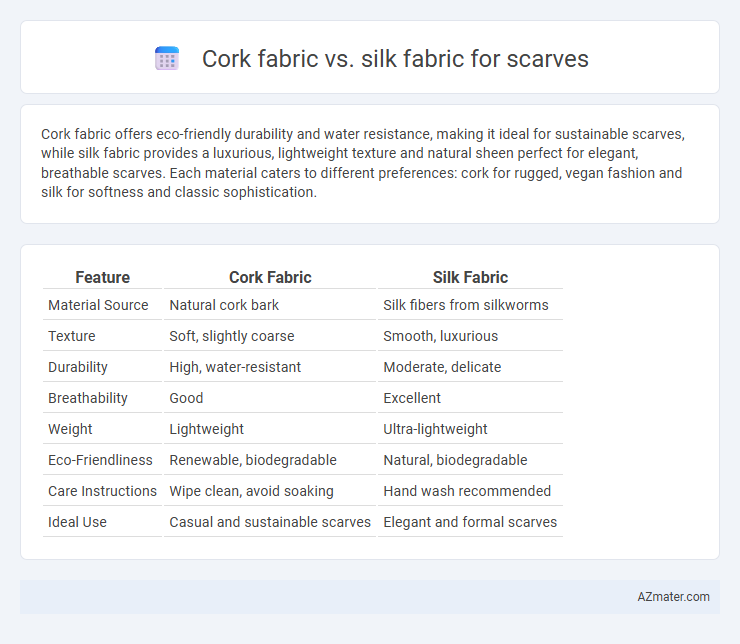Cork fabric offers eco-friendly durability and water resistance, making it ideal for sustainable scarves, while silk fabric provides a luxurious, lightweight texture and natural sheen perfect for elegant, breathable scarves. Each material caters to different preferences: cork for rugged, vegan fashion and silk for softness and classic sophistication.
Table of Comparison
| Feature | Cork Fabric | Silk Fabric |
|---|---|---|
| Material Source | Natural cork bark | Silk fibers from silkworms |
| Texture | Soft, slightly coarse | Smooth, luxurious |
| Durability | High, water-resistant | Moderate, delicate |
| Breathability | Good | Excellent |
| Weight | Lightweight | Ultra-lightweight |
| Eco-Friendliness | Renewable, biodegradable | Natural, biodegradable |
| Care Instructions | Wipe clean, avoid soaking | Hand wash recommended |
| Ideal Use | Casual and sustainable scarves | Elegant and formal scarves |
Introduction to Cork Fabric and Silk Fabric
Cork fabric, made from the bark of cork oak trees, offers a sustainable, lightweight, and water-resistant alternative for scarves, combining durability with a unique texture. Silk fabric, renowned for its luxurious smoothness, natural sheen, and exceptional breathability, provides a soft and elegant feel ideal for delicate scarves. Both materials present distinct advantages, with cork fabric excelling in eco-friendliness and resilience, while silk stands out for its classic elegance and comfort.
Origin and Production Processes
Cork fabric, derived from the bark of the cork oak tree primarily found in Portugal and Spain, undergoes a sustainable harvesting process where the bark is carefully stripped without harming the tree, then treated and laminated with textile backing to create a flexible material. Silk fabric originates from the silkworm cocoons, mainly produced in China and India, involving a meticulous process of sericulture where spinning, boiling, and reeling transform raw silk fibers into fine, smooth threads. The natural, eco-friendly cork production contrasts with the labor-intensive, delicate techniques required in traditional silk manufacturing, reflecting their distinct geographic and cultural origins.
Texture and Feel: Comfort on the Skin
Cork fabric offers a unique, slightly textured surface that feels soft yet firm against the skin, providing breathable comfort ideal for all-day wear. Silk fabric boasts a smooth, luxurious texture that glides effortlessly over the skin, known for its natural hypoallergenic and moisture-wicking properties, enhancing comfort and reducing irritation. Both materials support comfort in scarves, with cork fabric providing a distinctive tactile experience and silk fabric delivering classic softness and elegance.
Visual Appeal: Color, Pattern, and Sheen
Cork fabric offers a unique matte finish with natural variations in texture, presenting earthy tones and subtle patterns that highlight eco-friendly craftsmanship. Silk fabric showcases vibrant colors and intricate patterns with a lustrous sheen that enhances its luxurious, smooth surface. The visual appeal of silk scarves is characterized by intense color saturation and reflective gloss, while cork scarves emphasize organic aesthetics and understated elegance.
Durability and Longevity
Cork fabric offers superior durability and resistance to wear, making it an excellent choice for long-lasting scarves that withstand daily use without fraying or tearing. Silk fabric, while luxurious and soft, is delicate and prone to damage from friction, sunlight, and moisture, which can reduce its lifespan. For scarves requiring high longevity and robustness, cork fabric outperforms silk in maintaining structural integrity over time.
Sustainability and Eco-Friendliness
Cork fabric, derived from the bark of cork oak trees, is a highly sustainable and eco-friendly option for scarves due to its renewable harvesting process without harming the tree and its biodegradability. Silk fabric, while natural and biodegradable, involves intensive water use and mulberry cultivation, often contributing to environmental strain and ethical concerns related to silkworm farming. Choosing cork fabric supports reduced environmental impact through minimal resource consumption and promotes cruelty-free fashion compared to conventional silk production.
Hypoallergenic and Skin Sensitivity
Cork fabric is naturally hypoallergenic, resistant to dust mites and mold, making it an excellent choice for sensitive skin prone to allergies. Silk fabric also offers hypoallergenic properties but can sometimes cause irritation due to its protein structure for individuals with severe skin sensitivities. Choosing cork fabric for scarves ensures a breathable, gentle material that minimizes allergic reactions, whereas silk provides a smooth texture but may require careful consideration for highly sensitive users.
Maintenance and Care Requirements
Cork fabric scarves require minimal maintenance, needing only gentle wiping with a damp cloth to remove dirt, making them highly durable and water-resistant. Silk fabric scarves demand delicate care, including hand washing with mild detergent or dry cleaning to preserve their softness and prevent damage. Compared to silk, cork fabric offers easier, low-maintenance upkeep suitable for everyday use without compromising style.
Price Comparison: Affordability Versus Luxury
Cork fabric scarves are significantly more affordable than silk fabric scarves due to the lower cost of raw materials and sustainable production methods. Silk scarves, priced higher, offer a luxurious feel and sheen that justify their premium cost, often making them a status symbol. Choosing cork fabric balances eco-friendly affordability with style, while silk appeals to those seeking traditional luxury.
Conclusion: Which Fabric is Best for Scarves?
Cork fabric offers exceptional durability, water resistance, and eco-friendliness, making it a unique choice for scarves that require longevity and sustainability. Silk fabric provides unmatched softness, natural sheen, and breathable comfort, ideal for luxurious, lightweight scarves with elegant drape. For scarves, silk is best suited for style and comfort, while cork fabric is preferable for durability and eco-conscious fashion.

Infographic: Cork fabric vs Silk fabric for Scarf
 azmater.com
azmater.com